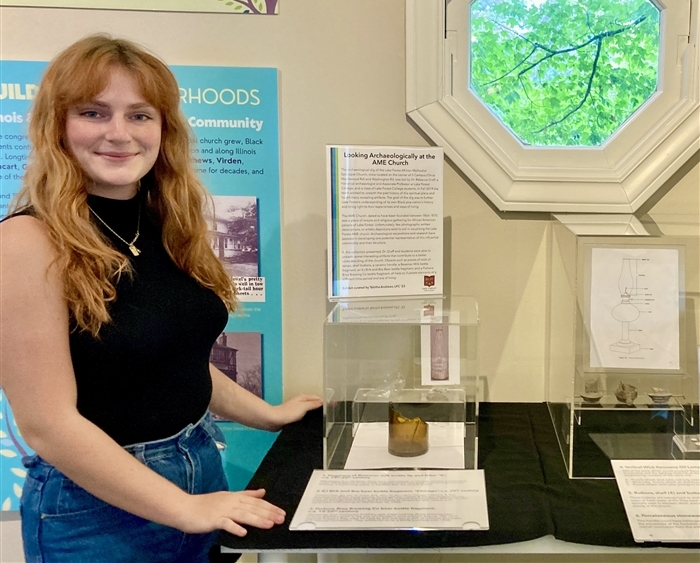Tabitha Andrews ’24 gains hands-on museum curation experience

Tabitha Andrews ’24 had a great experience this fall organizing and installing an exhibit at the History Center of Lake Forest-Lake Bluff showcasing artifacts unearthed on South Campus by students in 2019.
For the history major and sociology and anthropology minor, the real-life project was a dream come true.
“It was a really good experience for me as someone who wants to work with museums,” Andrews said. “It’s very rare at my age to have the experience of being able to say, ‘Oh, I installed my own artifact exhibit.’”
Andrews created “Looking Archaeologically at the AME Church” from artifacts excavated and analyzed several years ago by students in Associate Professor of Anthropology Rebecca Graff’s Archaeological Field Methods course.
Graff led her fall 2019 class in the archaeological dig at the previous site of the African Methodist Episcopal Church of Lake Forest. When it stood at the corner of Washington Avenue and South Campus Drive, the small building served as a place of worship from 1870 through the 1920s. The goal of the excavation was to raise awareness of the past and present Black communities of the North Shore and Chicago.
Four years later, Andrews spent her summer working as a Richter Scholar for Associate Professor of History and African American Studies Courtney Joseph researching the history of Lake Forest’s Black community while also excavating at IIT on Chicago’s South Side as part of Graff’s SOAN 205: Archaeology Field School. The Field School students searched for artifacts from the once-vibrant Armour Mission and Armour Flats, built by the Armour Meatpacking Company in the early 1880s for its workers. The IIT campus and surrounding areas were designated the Bronzeville–Black Metropolis National Heritage Area of Chicago in 2022.
“Tabby was perfectly placed to do this work,” Graff said of Andrews’ History Center project. “The small exhibit she put together added to Courtney’s amazing exhibit, ‘Deeply Rooted & Rising High: African American Experiences in Lake Forest,’ which already highlighted the former AME Church.”
The objective of the History Center project was “to photograph, research the artifacts, and choose which artifacts we wanted to put on display,” Andrews said. While the 2019 excavation didn’t uncover any infrastructure, “there were a few artifacts that really gave presence of the church.”
The artifacts Andrews chose to include in the display included three metal oil wick lamps, “all of those were still intact, which was just pretty amazing to see,” and shell buttons, which were popular during the time period and “the type of buttons that you would find on nicer clothing,” like clothing churchgoers of the era would wear.
A Bowman milk bottle—the major milk company in Chicago at the time—and a porcelaneous stoneware handle, “which would have been used for a teapot or a water basin or anything such as that,” were also included in the display, Andrews said.
Andrews worked with both Graff and Deputy Director of the History Center and Head of Curation Laurie Stein to choose the artifacts she felt best represented the church itself and the time period. Andrews put together write-ups of the exhibit items, a short summary of the dig, and a drawing of how she wanted the exhibit set up.
“We worked on how we wanted the artifacts to look, what we wanted to be the focal point, and what we wanted to be a little bit more on the sidelines,” Andrews said. “We played around with how to set it up and make it appealing in an esthetic way that attracts attention. The way that it did end up looking was just amazing.”
Related Links:
- On-campus dig uncovers signs of historic church
- Students gets practical experience in archaeology, Chicago history
- Explore the study of history and sociology and anthropology at Lake Forest College

